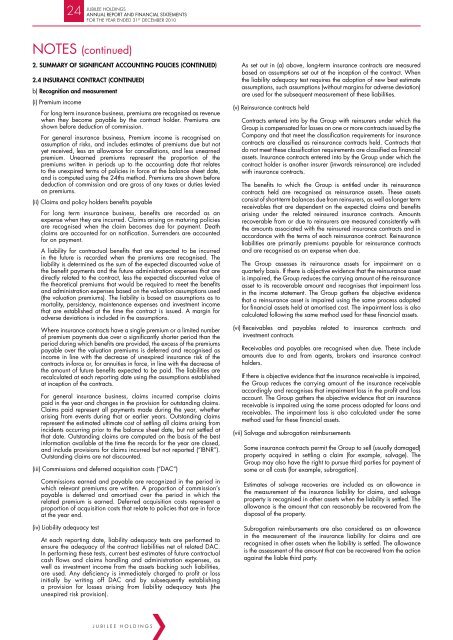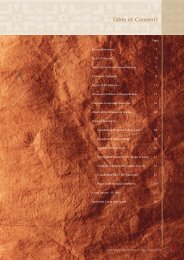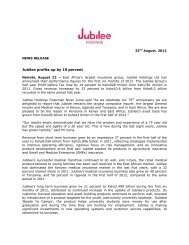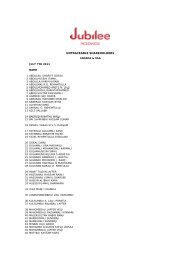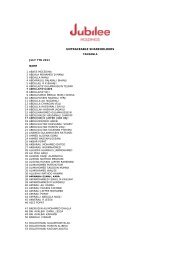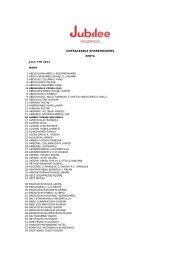Jubilee Insurance 2010 Annual Report
Jubilee Insurance 2010 Annual Report
Jubilee Insurance 2010 Annual Report
You also want an ePaper? Increase the reach of your titles
YUMPU automatically turns print PDFs into web optimized ePapers that Google loves.
24<br />
JUBILEE HOLDINGS<br />
ANNUAL REPORT AND FINANCIAL STATEMENTS<br />
FOR THE YEAR ENDED 31 ST DECEMBER <strong>2010</strong><br />
NOTES (continued)<br />
2. Summary of significant Accounting Policies (CONTINUED)<br />
2.4 INSURANCE CONTRACT (CONTINUED)<br />
b) Recognition and measurement<br />
(i) Premium income<br />
For long term insurance business, premiums are recognised as revenue<br />
when they become payable by the contract holder. Premiums are<br />
shown before deduction of commission.<br />
For general insurance business, Premium income is recognised on<br />
assumption of risks, and includes estimates of premiums due but not<br />
yet received, less an allowance for cancellations, and less unearned<br />
premium. Unearned premiums represent the proportion of the<br />
premiums written in periods up to the accounting date that relates<br />
to the unexpired terms of policies in force at the balance sheet date,<br />
and is computed using the 24ths method. Premiums are shown before<br />
deduction of commission and are gross of any taxes or duties levied<br />
on premiums.<br />
(ii) Claims and policy holders benefits payable<br />
For long term insurance business, benefits are recorded as an<br />
expense when they are incurred. Claims arising on maturing policies<br />
are recognised when the claim becomes due for payment. Death<br />
claims are accounted for on notification. Surrenders are accounted<br />
for on payment.<br />
A liability for contractual benefits that are expected to be incurred<br />
in the future is recorded when the premiums are recognised. The<br />
liability is determined as the sum of the expected discounted value of<br />
the benefit payments and the future administration expenses that are<br />
directly related to the contract, less the expected discounted value of<br />
the theoretical premiums that would be required to meet the benefits<br />
and administration expenses based on the valuation assumptions used<br />
(the valuation premiums). The liability is based on assumptions as to<br />
mortality, persistency, maintenance expenses and investment income<br />
that are established at the time the contract is issued. A margin for<br />
adverse deviations is included in the assumptions.<br />
Where insurance contracts have a single premium or a limited number<br />
of premium payments due over a significantly shorter period than the<br />
period during which benefits are provided, the excess of the premiums<br />
payable over the valuation premiums is deferred and recognised as<br />
income in line with the decrease of unexpired insurance risk of the<br />
contracts in-force or, for annuities in force, in line with the decrease of<br />
the amount of future benefits expected to be paid. The liabilities are<br />
recalculated at each reporting date using the assumptions established<br />
at inception of the contracts.<br />
For general insurance business, claims incurred comprise claims<br />
paid in the year and changes in the provision for outstanding claims.<br />
Claims paid represent all payments made during the year, whether<br />
arising from events during that or earlier years. Outstanding claims<br />
represent the estimated ultimate cost of settling all claims arising from<br />
incidents occurring prior to the balance sheet date, but not settled at<br />
that date. Outstanding claims are computed on the basis of the best<br />
information available at the time the records for the year are closed,<br />
and include provisions for claims incurred but not reported (“IBNR”).<br />
Outstanding claims are not discounted.<br />
(iii) Commissions and deferred acquisition costs (“DAC”)<br />
Commissions earned and payable are recognized in the period in<br />
which relevant premiums are written. A proportion of commission’s<br />
payable is deferred and amortised over the period in which the<br />
related premium is earned. Deferred acquisition costs represent a<br />
proportion of acquisition costs that relate to policies that are in force<br />
at the year end.<br />
(iv) Liability adequacy test<br />
At each reporting date, liability adequacy tests are performed to<br />
ensure the adequacy of the contract liabilities net of related DAC.<br />
In performing these tests, current best estimates of future contractual<br />
cash flows and claims handling and administration expenses, as<br />
well as investment income from the assets backing such liabilities,<br />
are used. Any deficiency is immediately charged to profit or loss<br />
initially by writing off DAC and by subsequently establishing<br />
a provision for losses arising from liability adequacy tests (the<br />
unexpired risk provision).<br />
As set out in (a) above, long-term insurance contracts are measured<br />
based on assumptions set out at the inception of the contract. When<br />
the liability adequacy test requires the adoption of new best estimate<br />
assumptions, such assumptions (without margins for adverse deviation)<br />
are used for the subsequent measurement of these liabilities.<br />
(v) Reinsurance contracts held<br />
Contracts entered into by the Group with reinsurers under which the<br />
Group is compensated for losses on one or more contracts issued by the<br />
Company and that meet the classification requirements for insurance<br />
contracts are classified as reinsurance contracts held. Contracts that<br />
do not meet these classification requirements are classified as financial<br />
assets. <strong>Insurance</strong> contracts entered into by the Group under which the<br />
contract holder is another insurer (inwards reinsurance) are included<br />
with insurance contracts.<br />
The benefits to which the Group is entitled under its reinsurance<br />
contracts held are recognised as reinsurance assets. These assets<br />
consist of short-term balances due from reinsurers, as well as longer term<br />
receivables that are dependent on the expected claims and benefits<br />
arising under the related reinsured insurance contracts. Amounts<br />
recoverable from or due to reinsurers are measured consistently with<br />
the amounts associated with the reinsured insurance contracts and in<br />
accordance with the terms of each reinsurance contract. Reinsurance<br />
liabilities are primarily premiums payable for reinsurance contracts<br />
and are recognised as an expense when due.<br />
The Group assesses its reinsurance assets for impairment on a<br />
quarterly basis. If there is objective evidence that the reinsurance asset<br />
is impaired, the Group reduces the carrying amount of the reinsurance<br />
asset to its recoverable amount and recognises that impairment loss<br />
in the income statement. The Group gathers the objective evidence<br />
that a reinsurance asset is impaired using the same process adopted<br />
for financial assets held at amortised cost. The impairment loss is also<br />
calculated following the same method used for these financial assets.<br />
(vi) Receivables and payables related to insurance contracts and<br />
investment contracts<br />
Receivables and payables are recognised when due. These include<br />
amounts due to and from agents, brokers and insurance contract<br />
holders.<br />
If there is objective evidence that the insurance receivable is impaired,<br />
the Group reduces the carrying amount of the insurance receivable<br />
accordingly and recognises that impairment loss in the profit and loss<br />
account. The Group gathers the objective evidence that an insurance<br />
receivable is impaired using the same process adopted for loans and<br />
receivables. The impairment loss is also calculated under the same<br />
method used for these financial assets.<br />
(vii) Salvage and subrogation reimbursements<br />
Some insurance contracts permit the Group to sell (usually damaged)<br />
property acquired in settling a claim (for example, salvage). The<br />
Group may also have the right to pursue third parties for payment of<br />
some or all costs (for example, subrogation).<br />
Estimates of salvage recoveries are included as an allowance in<br />
the measurement of the insurance liability for claims, and salvage<br />
property is recognised in other assets when the liability is settled. The<br />
allowance is the amount that can reasonably be recovered from the<br />
disposal of the property.<br />
Subrogation reimbursements are also considered as an allowance<br />
in the measurement of the insurance liability for claims and are<br />
recognised in other assets when the liability is settled. The allowance<br />
is the assessment of the amount that can be recovered from the action<br />
against the liable third party.<br />
JUBILEE HOLDINGS


